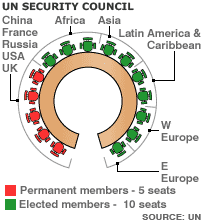This is the third of a series of posts concerning Geo-engineering, or the deliberate the intentional large-scale manipulation of the environment.
The first post introduced the topic which consists of two types of strategies i.e..e solar radiation management and carbon capture and sequestration. The second post detailed the approach of one of the leading scientists in the field, Harvard’s David Keith who has put forward a proposal for spraying sulphate aerosols high into the atmosphere and also founded a start up developing technology to capture carbon from the atmosphere and convert it into fuel.
This post deals with the issue of governing the use of Geo-engineering and its implications for geo-politics. At issue is the fact that when applied at scale, geo-engineeering technologies will impact the entire planet and thus, in all fairness, the deployment of such technologies should probably be taken by humanity as a whole.
United Nations ?

One answer would be to place the whole thing under the auspices of the United Nations which in theory at least represents the world. There are at least three problems with this approach. One is that the UN actually represents the governments of the world, regardless of whether the degree to which those governments actually do represent the will of their people. Secondly, the UN itself is organized such that some countries, like the five permannent members of the security council have more of a say than others on specific questions. Finally, the UN is very slow and bureaucratic in its operations and thus if geo-engineering was needed inn the relatively short term, it is difficult to see how the body could get through the design and apporval process in any kind of reasonable time frame.
Rouge Actors

An example of ocean fertilisation is the injection of iron oxides into the sea which will cause algae to bloom. The algae absorbs CO2 and then in theory sinks to the sea floor. Californian entrepreneur Russ George conducted an experiment in July of 2012 using 100 tons of iron dust and causing a plankton bloom off the coast of Brittish Columbia.
According to George, the test was a complete success and the resulting plankton is responsible for the surge in the salmon catch three years later. and the process he is working on will actually bring sea life back to where it is supposed to be as well as locking in excess CO2. The Guardian quotes a representative of ETC, a group which calls for a ban on all geo-engineering, who calls George a “rouge engineer” and underlines the inherent danger of allowing private citizens or corporations to experiment with the world’s climate system.
The Oxford Principles
One of the serious research centres looking deeply into Engineering is located at the Oxford Martin School at Oxford University. Recognising the issues cited above, a group of academics put together a set of five principles which they feel should be used to govern the emerging field.
The principles are:
1. Geoengineering to be regulated as a public good.
2. Public participation in geoengineering decision‐making.
3. Disclosure of geoengineering research and open publication of results.
4. Independent assessment of impacts.
5. Governance before deployment.
Whats next?
While the principles have been approved by a committee of the UK’s house of commons, the world is far from taking the topic of geo-engineering seriously and putting in place any kind of global monitoring and control system of the kind advocated for by ETS.
Research, is however, reportedly underway in a number of countires and I believe we may see the unilateral use of geo-engineering technologies if and when a specific country finds that it is in its national interest to do so.

